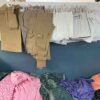Echo Earth & The Shift in Global Sourcing: Why U.S. Buyers Are Turning to India
The global fabric and fashion industry is undergoing a monumental shift. As sustainability becomes a priority in the world of textiles, U.S. buyers are increasingly looking for eco-friendly alternatives to traditional fabrics. One material that’s gaining significant traction is hemp fabric, known for its sustainability and versatility. With the growing need for sustainable fabrics, many buyers are now turning to India — a country that’s becoming a global leader in the production of hemp fabric textiles. At Echo Earth, we understand the importance of this shift and how hemp fashion and hemp fabric textiles are not just a trend, but a sustainable solution to the global textile industry’s environmental challenges. In this blog, we’ll explore why U.S. buyers are turning to India for hemp sourcing and how this eco-conscious movement is transforming the fabric industry. 1. The Growing Demand for Sustainable Fabrics As environmental concerns continue to dominate conversations, consumers are becoming more conscious of their purchasing decisions. Sustainability in fashion is no longer just a buzzword — it’s a movement. Sustainable fabrics like hemp fabric are quickly becoming the go-to choice for eco-conscious buyers. Unlike conventional textiles that contribute to pollution and resource depletion, hemp is a highly sustainable option that offers durability, breathability, and biodegradability. India has become a pivotal player in the global textile market, especially in the sustainable fabric space. With its rich history in textile production and agricultural expertise, the country is perfectly positioned to lead the charge in hemp fabric textiles. Hemp requires far less water and pesticides compared to cotton, making it a more eco-friendly alternative. This makes India an attractive source for hemp fabric for U.S. buyers seeking a more sustainable supply chain. 2. Why U.S. Buyers Are Turning to India for Hemp Fabric Cost-Effectiveness One of the primary reasons U.S. buyers are sourcing hemp fabric textiles from India is cost-effectiveness. India’s textile industry has long been known for its competitive pricing, and with advancements in hemp cultivation and processing, the production costs of hemp fabric are significantly lower than many alternatives. This makes hemp an affordable eco-friendly option for buyers in the U.S. looking to adopt sustainable practices without inflating their costs. India’s government also supports the cultivation of hemp, with policies that promote its production as part of the country’s sustainability goals. This combination of favorable pricing and government support creates a perfect environment for U.S. buyers to source hemp fabric with confidence. Advanced Manufacturing Capabilities India’s textile industry is renowned for its vast manufacturing capabilities, ranging from handloom to large-scale industrial production. With hemp fabric textiles becoming more widely produced, India’s manufacturing capabilities have evolved to meet the growing global demand for hemp fashion. The country is home to state-of-the-art facilities that can produce high-quality hemp fabric, ensuring that U.S. buyers receive products that meet international standards. Moreover, Indian manufacturers are increasingly adopting advanced sustainable practices in the production of hemp fabric textiles, ensuring that every step of the process — from cultivation to fabric production — is environmentally friendly. This further solidifies India’s position as a reliable and ethical source of hemp fabric for U.S. buyers. 3. The Environmental Benefits of Hemp Fabric Hemp is one of the most sustainable materials in the world, and its environmental benefits are becoming a significant reason for its popularity. Unlike synthetic fabrics or conventional cotton, hemp fabric requires minimal water, no pesticides, and little to no fertilizers to grow. It also helps improve soil health by naturally replenishing the nutrients in the ground, making it a highly renewable resource. In comparison, traditional textile manufacturing processes are responsible for massive water consumption, toxic chemical usage, and harmful emissions. The shift towards sustainable fabrics like hemp fabric textiles is a step towards reducing the fashion industry’s carbon footprint and promoting a more sustainable future. For U.S. buyers, this shift is an opportunity to align their purchasing decisions with environmental values, ensuring that their products not only meet consumer demand but also support a global movement toward sustainability. 4. The Rise of Hemp Fashion in the Global Market The demand for hemp fashion is rapidly increasing, and it’s easy to see why. Hemp’s natural fibers are not only durable and strong but also comfortable, making them perfect for a wide range of fashion products — from clothing to accessories. Hemp’s natural properties make it breathable, moisture-wicking, and naturally anti-bacterial, which is why it’s increasingly used in everything from hemp t-shirts to hemp dresses and even hemp-based footwear. U.S. buyers are keen to tap into this growing demand for Organic Hemp Clothing fashion. By sourcing hemp fabric from India, they can offer their customers high-quality, eco-friendly products that resonate with the sustainability values of today’s conscious consumer. 5. Challenges and Opportunities in Hemp Sourcing While the benefits of sourcing hemp fabric textiles from India are clear, there are still some challenges. One of the primary challenges is the perception of hemp as a “niche” product. Despite its sustainability benefits, hemp has historically been associated with limited use in the fashion industry. However, this perception is rapidly changing, as hemp fashion gains momentum among consumers and fashion brands worldwide. The opportunity for growth in the global hemp market is significant. As more U.S. buyers turn to India for hemp fabric sourcing, they’re helping to establish hemp as a mainstream fabric option. This shift is not only good for the environment but also opens up new avenues for brands to innovate and appeal to a more eco-conscious consumer base. Conclusion The global sourcing of textiles is evolving, with U.S. buyers increasingly turning to India for hemp fabric textiles. As sustainability becomes a driving force in the fashion industry, Organic Hemp Clothing fabric offers a perfect solution for companies looking to reduce their environmental footprint while still delivering high-quality products. The rise of hemp fashion is not just a trend, but a step toward a more sustainable future — and India is leading the charge in meeting this demand. At Echo Earth, we’re proud to be part of





